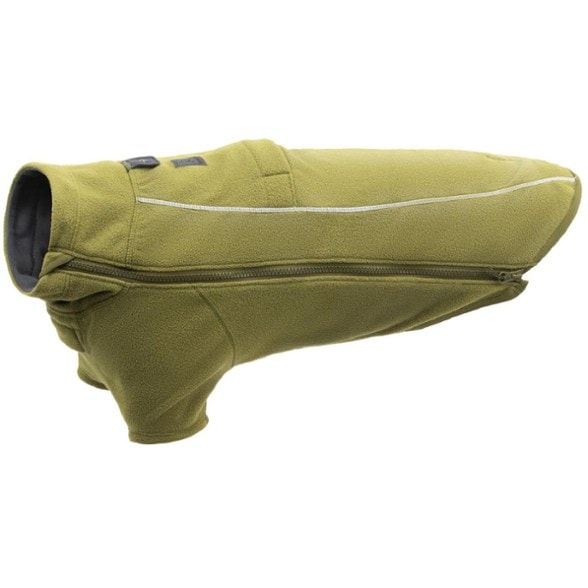Best Camping Gear For Dogs
Cates Compass contains affiliate links and is a member of the Amazon Services LLC Associates Program. If you make a purchase using one of these Amazon links, I may receive compensation at no extra cost to you. Read my disclaimer for more information.
Camping with your pup? You’ll need more than just an extra bowl!
Bringing your dog camping can be a lot of fun—but it takes a little extra planning. Between keeping them warm at night and making sure they stay safe around camp, there are a few things I never head out without.
Over time, and with a few lessons learned the hard way, I’ve figured out which camping gear for dogs makes life easier. In this post, I’m sharing what I always pack now, along with a few tips to help you skip the rookie mistakes I made early on.
Quick Guide: 6 Things I Always Bring With
1. Camping blanket
2. Camping dog bed
3. Leash, electric collar, and glow-up night collar
4. Treat toy and plenty of treats
5. Collapsible bowl
6. Poop bags
Sleeping Bag
We want our dogs to be safe and comfortable at camp, right? A dog sleeping bag can help with both.
It gives them a soft spot to curl up, helps them retain body heat overnight, and keeps them off the hard, cold ground. Some dogs will burrow right in, while others are happy to just lie on top. Either way, it adds an extra layer of comfort that can make a big difference, especially on cooler nights.
They’re also easy to pack and clean, which is always a win after a dusty or muddy weekend. And really, it means you get a better night’s sleep too—because you know they’re warm, settled, and happy.
I don’t always bring a sleeping bag for my dog because it’s relatively warm where we live. Only during the cooler months does this become an essential part of our camping kit, and it keeps him warm on the nights where the temperature drops closer to freezing.
Ruffwear: Highlands Dog Sleeping Bag
This one’s insulated, water-resistant, and super easy to roll up. I love how lightweight it is—it barely takes up any room in my pack, and it helps keep your dog warm without overheating. Great for cooler nights or early morning chill.
Sleeping Pad/Dog Bed
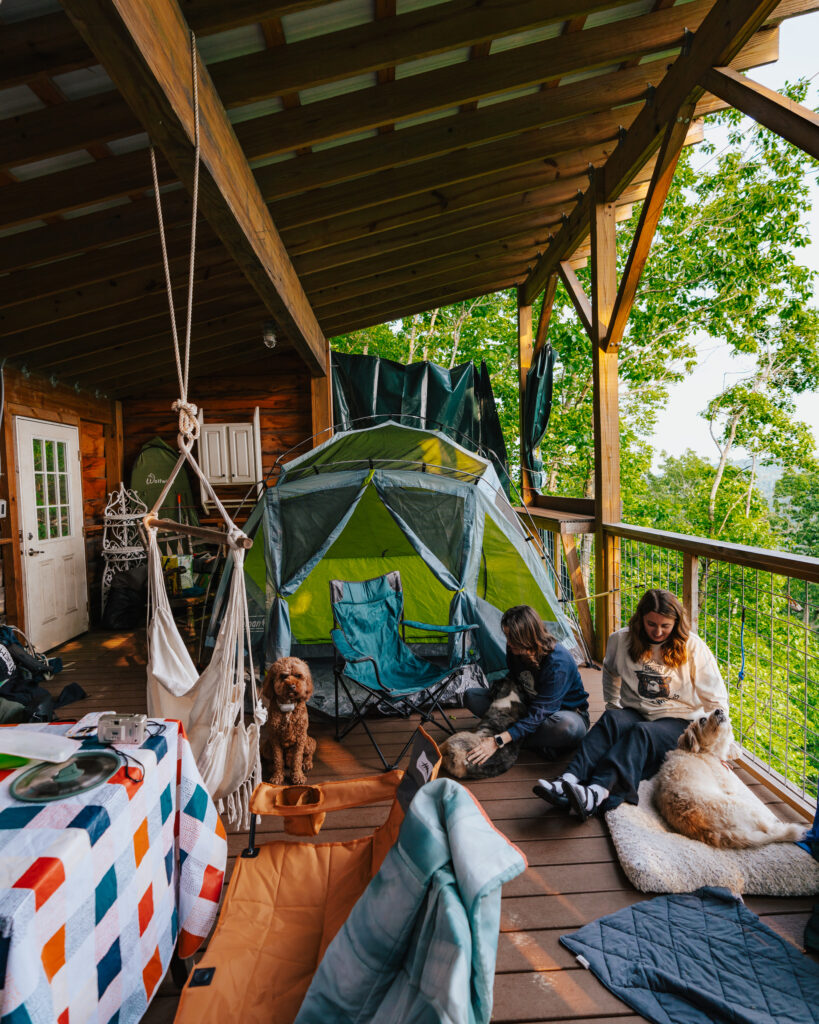
Some dogs like to sprawl out, some curl into a ball, and some do a bit of both. If your dog isn’t into the sleeping bag life or needs a little extra comfort, a camping bed or sleeping pad is a great option.
It gives them a bit of cushioning, keeps them off the ground, and helps them settle into a space that feels like their own. It’s also a good pick for older dogs who need a little extra joint support after a day of hiking or exploring.
Look for something lightweight, durable, and easy to shake out at the end of the trip. Bonus points if it rolls up easily and fits inside your tent without taking over your entire sleeping area.
I used to just camp with my dog’s bed from home, but I got sick of constantly needing to wash it. I found having a dedicated bed that’s made for a little rougher use and dirtier conditions has been a game-changer.
Lightweight, soft, and easy to clean. The microsuede top is cozy, and the recycled fill gives just enough cushion after a long day outside. It packs down well and fits easily in a tent or crate, which makes it a great camping option.
Camp Blanket
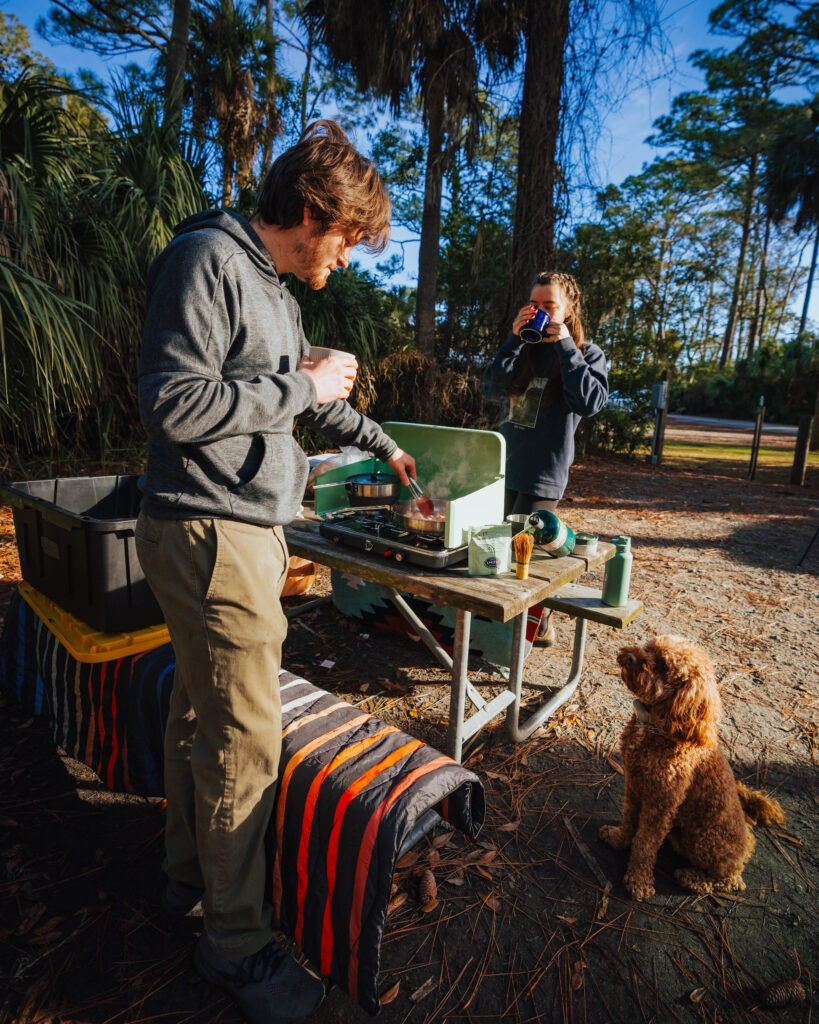
Even in summer, evenings can get chilly fast. I’ve always packed a blanket we can curl up on and that I can throw over us both if it gets cold.
My dog knows this blanket is his, and he gets so excited when I break it out while camping. It’s part of his routine and something that makes being away from home less scary.
I used to use an old blanket that I didn’t mind getting dirty, but after enough trips, I realised I needed something that holds up better outside and is easy to wash. So I looked for an actual camping blanket—and now it comes everywhere with me.
My Nomadix Puffer Blanket is warm, easy to wash, tough enough for muddy paws or damp ground, and the patterns are so cute too (especially the National Parks Monuments one!)
Packs down to nearly nothing, which is great when space is tight. It’s made with recycled materials and has snaps so you can use it as a cloak, blanket, or sleeping bag. It’s sandproof and water-resistant too!
Electric Collar
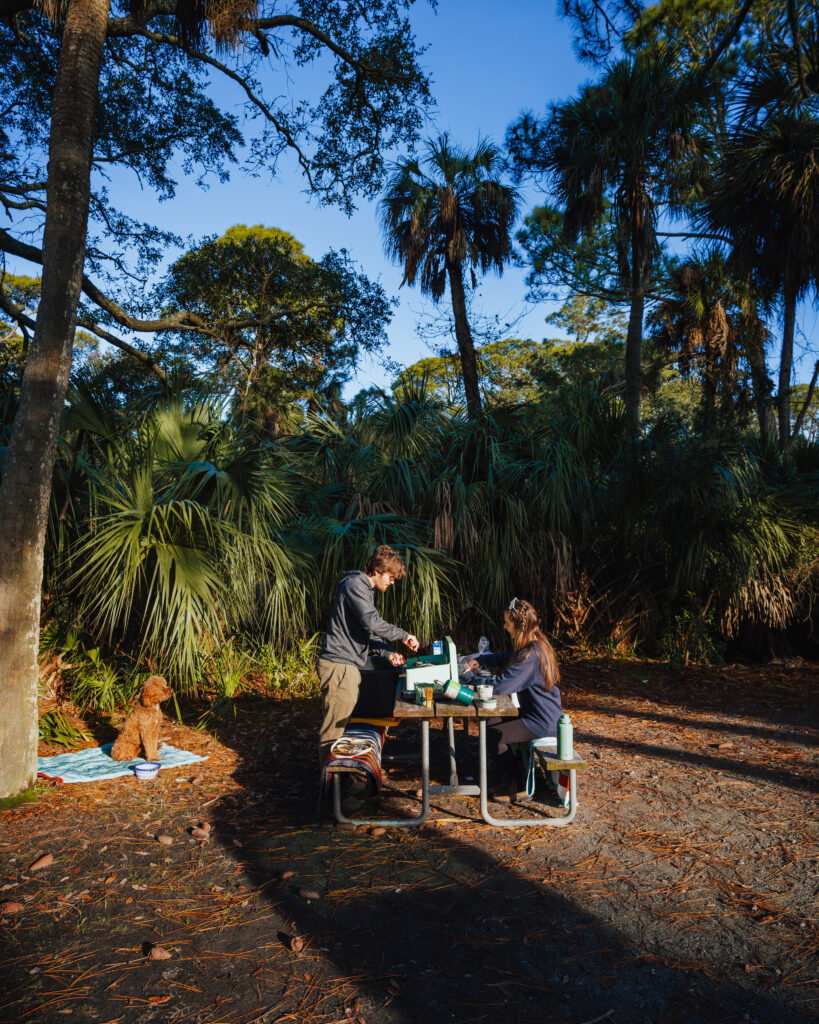
This isn’t for everyone, but used responsibly, it can mean the difference between a dream trip and a disaster trip.
If your dog already has good recall and you’re planning to give them some off-leash time, an e-collar can be a great backup tool. I mostly use the beep or vibration features to gently get my dog’s attention if he starts to wander or lose focus.
It’s especially helpful in wide open spaces where your voice might not carry, or if you’re camping somewhere with wildlife. Just make sure your dog is trained on it before the trip and always use it with care.
Also, ensure it is legal/safe to use the e-collar in the area you want to use it. Many amazing hipcamps allow dogs off-leash, but many camping areas do not.
This one’s waterproof, holds a charge well, and has a solid range that actually works for camp setups. The tone and vibration settings are intuitive and give you a gentle, reliable way to get your dog’s attention when needed. I’ve been using it for years, and it’s held up really well!
Collapsible Bowl
When you’re trying to pack light, bulky bowls just don’t make sense. A collapsible one takes up hardly any space, and it’s one of the things I use the most on any camping trip.
I usually bring two—one for food, one for water—and just fold them up and toss them in my daypack. They’re perfect for hike breaks or quick stops at camp. Just fill with water from your bottle and you’re good to go.
It needs to be durable, easy to clean, and hold its shape when filled, which is why I recommend this Ruffwear one.
Lightweight, folds flat, and holds up well on the trail. I like that it doesn’t collapse in on itself when full, and it’s easy to rinse out at the end of the day. Just a no-fuss travel bowl.
Plenty of Treats
Treats are one of the things I always end up wishing I’d packed more of. They’re great for rewarding good trail behavior, distracting during downtime, and keeping your dog happy and engaged around camp.
If your dog usually gets five treats a day, pack ten. You’ll go through them quicker than you think—especially if there’s recall practice involved or a squirrel situation.
Stick to treats they already know and tolerate well. A camping trip isn’t the time to test out something new. The last thing you want is a stomach issue when you’re sharing a tent!
Having something durable and easy to use to hold your treats is a must while camping! I like to throw a bunch in one bag so I don’t have 6 different treat bags to pack.
My Top Picks

A reusable, leakproof silicone bag that keeps treats fresh and packs flat in your daypack.
Clips onto your waist with a magnetic closure for easy, one-handed access during training or hikes.
Treat Toy
These toys are a game-changer when you need your dog to chill for a bit at camp. Fill one with treats or a bit of peanut butter, and it’ll keep them busy while you cook, set up your tent, or just sit and enjoy the quiet for a minute.
They’re also great for dogs who need a little help settling down in new environments. Just make sure it’s something durable enough for chewing and easy to rinse out if things get messy. Bonus if it fits in your daypack for on-the-go use, too.
Don’t leave these in the tent at night, especially if you’re in bear country! I always make sure to pack up all my dogs’ stuff (except for a water bowl) and put it back in my car before climbing into the tent for the night.
My Two Favorites

I fill it with peanut butter or a few treats before the trip—it’s durable, keeps my dog busy, and rinses out easily.
Better for long chews as it holds them in place, so they’ll stay busy for longer. My dog has had this since he was a puppy, and we got one specifically for camping! I use it at night around the fire or when he needs engagement, but I just want to chill at camp.
Sweater or Jacket For Cold Nights
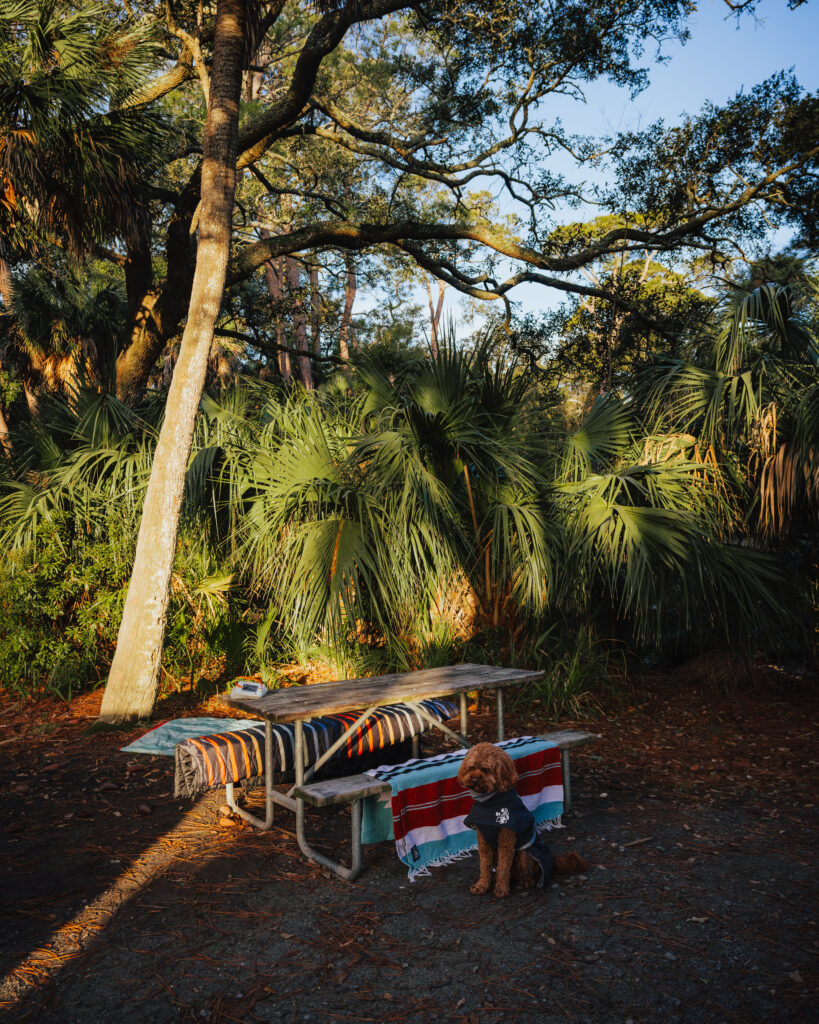
If your dog has a short coat or just runs cold, a jacket or sweater is a smart thing to pack. Even in summer, nights can be chilly in the mountains, especially after a long hike or if they’ve gotten wet. An extra layer can make a big difference in how well they settle in for the night.
I usually bring something lightweight and easy to throw on if the temperature drops, and I’ll swap it for a heavier coat if it’s later in the season or unseasonably cold. Look for something that fits snug but still lets them move freely, and that you can get on and off without a wrestling match.
The Three on Rotation in our Household
Part fleece, part insulated puffer- let’s your pup stay warm without losing mobility.
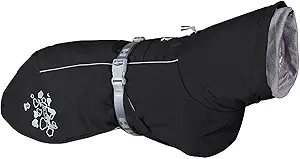
Hurrta Extreme Warmer Dog Jacket
This is built for serious cold, with an adjustable fit that keeps warmth in and snow out! I saw so many dogs wearing this when I was backpacking in close to freezing temperatures in the Canadian Rockies. This is the jacket I use for our dog when I know we’re going to have a chilly night.
Ruffwear Climate Changer Fleece Jacket
It zips up easily, works with most harnesses, and has reflective trim for visibility. A jacket like this is perfect for shoulder season or when you’re high up in the mountains in the summer, and an extra layer will keep them comfy!
Glow Up Night Collar
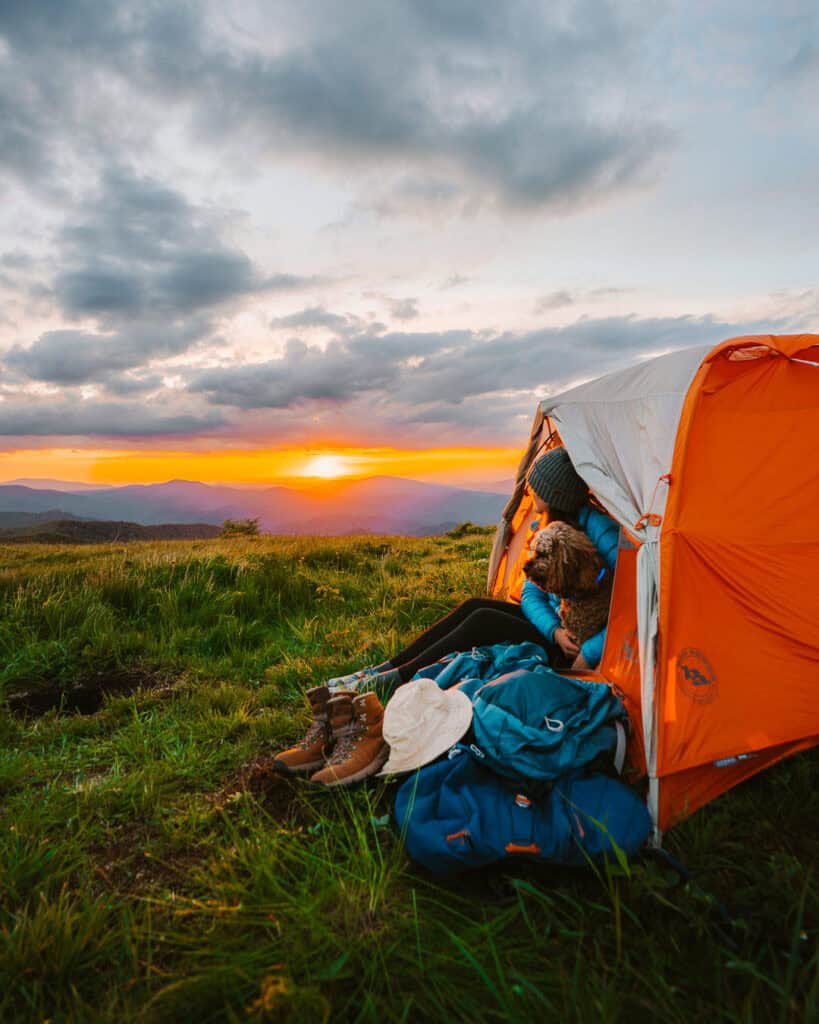
Once the sun sets, it’s surprisingly easy to lose track of your dog around camp. A glow-up collar fixes that instantly.
I clip one on as soon as it gets dark so I can see where they are without constantly calling or grabbing a flashlight. It’s especially handy for those late-night bathroom breaks—no more awkwardly staring into the dark trying to guess if they’ve “gone” yet.
Simple, affordable, and genuinely useful to have with you on your trips. I also love using it at home for evening walks or if I’m going to let our dog out in the yard at night and I want to be able to find him easily.
NiteHowl Max Rechargeable Safety Necklace
Rechargeable, easy to fit, and bright enough to actually be helpful. You can trim it to size, and it slips on without a buckle.
Dog-Friendly Tent (ie DURABLE)
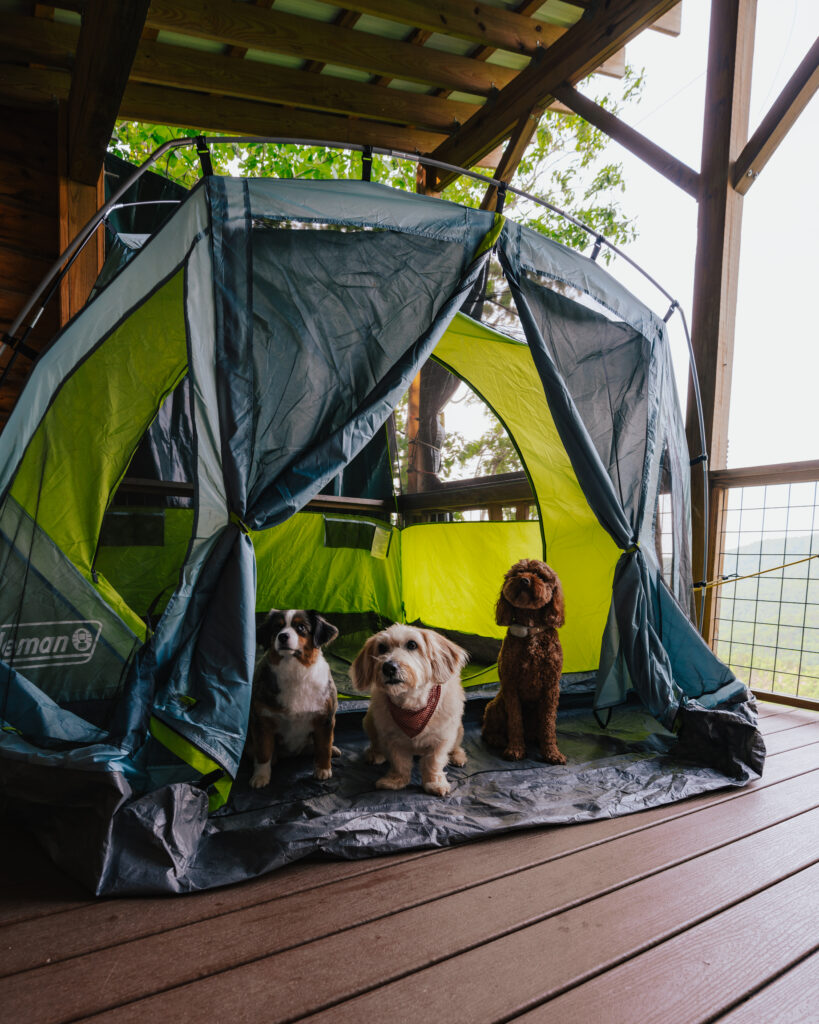
You don’t need a separate tent just for your dog, but it’s worth making sure your own tent can handle a canine camper.
That means enough space for them to sleep comfortably, plus materials that can hold up to paws and claws. I usually bring a ground cloth or old blanket to protect the floor, and always size up—what’s a snug fit for two people becomes very tight when you add a dog and their gear.
Buy cheap, buy twice definitely applies here. Thin tent walls and sharp claws don’t mix well, and patching a ripped tent is no fun mid-trip.
The Ones I Recommend
Coleman Skydome Dark Room Tent
Spacious with darkroom tech to block morning sun, and keep the inside cooler during warm afternoons.
High-Quality Leash
A reliable leash is a must when you’re camping with dogs. Even the calmest dog can get curious in new surroundings, so it’s important to have something strong, comfortable, and ready for daily use.
I bring one that holds up well for both hiking and hanging around camp. You’ll be clipping and unclipping it all day, so it’s worth choosing one that feels good in your hand and won’t wear out quickly.
My personal favorite is easier to clean than most leashes, but it is a little on the pricey side. We’ve been using it for 5 years, and it’s held up super well.
The 2 Leashes Worth Packing
The stretch gives your dog a bit more freedom on the trail without pulling you off your feet.
Poop Bags
Not the most exciting item on the list, but definitely one of the most important. Packing enough poop bags is non-negotiable when you’re camping with dogs.
I stash rolls in my hiking pack, jacket pockets, and gear bin so I’m never caught without one. Cleaning up after your dog is part of camping responsibly and a key part of following Leave No Trace guidelines.
It’s not glamorous, but it matters. Leaving your site clean keeps the campsites open to dogs and helps protect the spaces we all enjoy.
Biodegradable, durable, and easy to stash in your pack. They tear cleanly, and don’t fall apart mid-use. I always bring more than I think I’ll need.
Long Lead Stake
When you’re hanging around camp, a long lead gives your dog some freedom to explore without wandering off. I usually set up a 20 to 30-foot cable tied to a sturdy stake in the ground so they can sniff, nap, and move around while I’m setting up the tent or cooking.
It’s a nice way for them to feel part of the action without needing constant leash-handling. Just make sure whatever stake or tie-out you bring is strong enough to hold steady and that you always keep an eye on them while they’re clipped in.
This is an especially great option if the campground does not allow off-leash or your dog is not trained on an electric collar. I always ensure that there aren’t too many obstacles that my dog can get tangled around (if you know, you know).
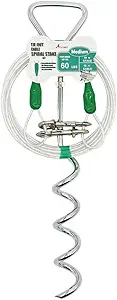
Petest Spiral Reflective Stake Out
Easy to use, reflective for nighttime visibility, and holds steady when your dog gets the zoomies.
Seat Cover
Camping usually means dirt, wet paws, and a lot of hair, and that all ends up in your car if you’re not prepared. A good seat cover saves your upholstery and makes post-trip cleanup so much easier.
I use a hammock-style one that protects the backseat and also keeps my dog from sliding into the footwell if I brake suddenly. It’s not fancy, but it makes a big difference after a muddy weekend.
I like that this waterproof cover can also turn into a hammock if necessary and clips to the back seat to stay secure.
Dog First Aid Kit
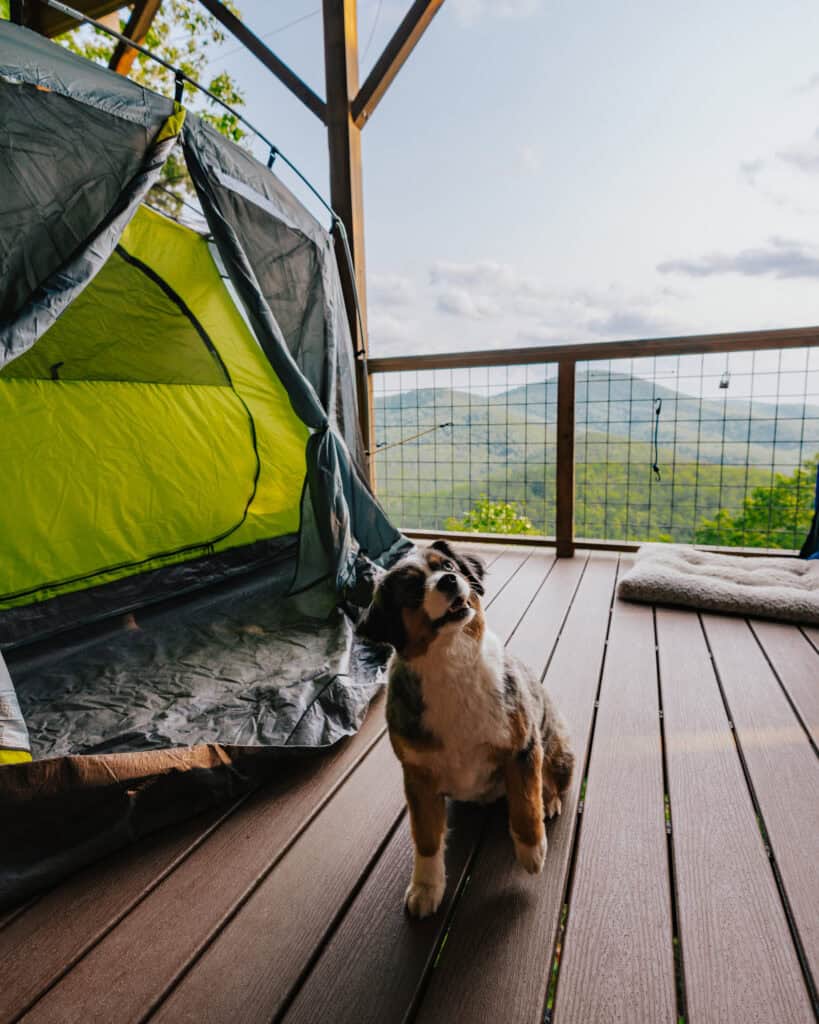
Scrapes, thorns, ticks—camping comes with a few more risks when you’ve got a dog along for the ride. I always pack a small first aid kit just for them, whether it’s a pre-made version or one I’ve put together myself.
Bandages, tweezers, antiseptic wipes, and any medications they’re on are the essentials. I also throw in a copy of their vaccination records, just in case. You might not need it, but if something happens mid-trip, you’ll be glad it’s there.
Compact, trail-ready, and stocked with the basics for minor injuries. Easy to toss in your pack and light enough that it’s never a hassle to carry.
Bonus Extras to Consider
Not every trip needs these, but depending on your destination (or your dog!), these extra bits of camping gear for dogs have come in handy more than once:
- Cooling vest/bandana (summer staple for us in the Southeast U.S.)
- Microfiber Dog Towel
- Wipes for dirty paws (so handy after a muddy trail so they don’t track mud into the tent)
- Portable dog fence or playpen (great for puppies who have a little less training)
- Dog-safe bug spray (game changer during mosquito/tick season)
- Pain-Free Tick Remover
Tips for Camping With Dogs
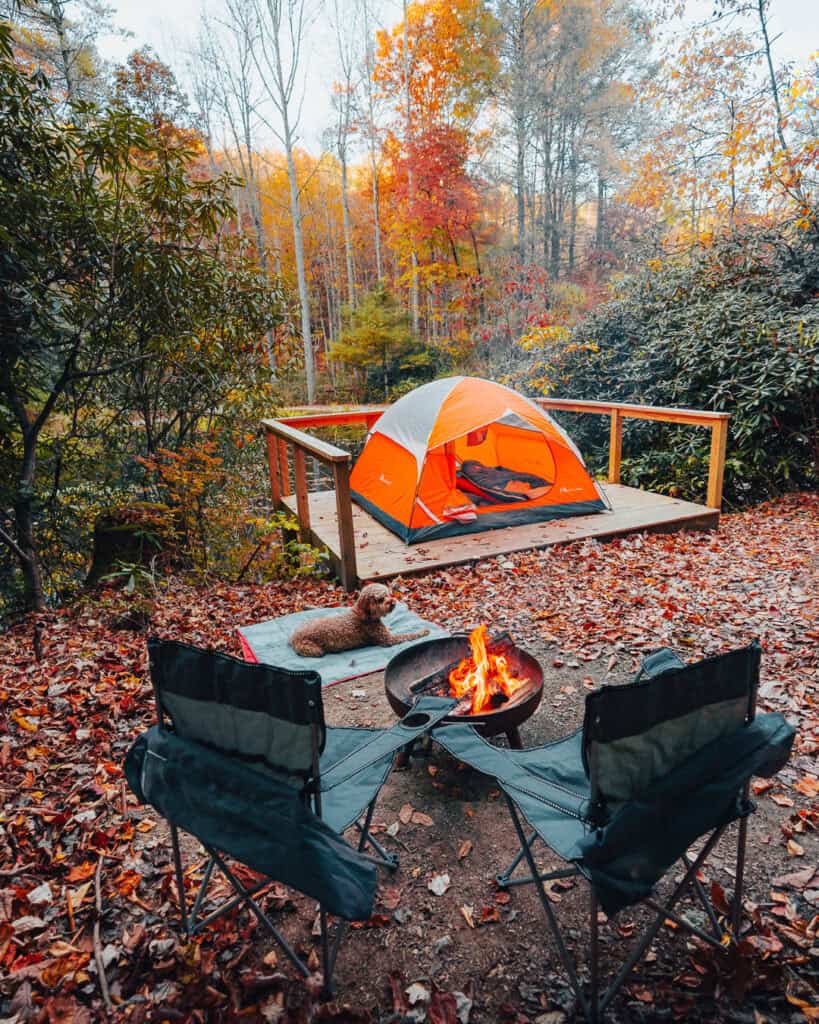
Packing the right gear is a great start, but there are a few extra things that can make camping with your dog go a whole lot smoother.
Check for Local Hazards
Before you head out, do a quick search for any wildlife or environmental risks in the area. Are there bears? Snakes? Coyotes? Even just rough terrain or sharp plants?
Knowing what’s out there helps you plan ahead—things like keeping your dog leashed, using an e-collar, or storing food properly can make a big difference.
Know Where the Nearest Vet Is
Hopefully, you won’t need it, but I always save the number and address of the closest emergency vet before I leave. If something happens on the trail or at camp, you’ll want that info ready to go, not buried in a spotty cell signal or a panicked Google search.
Prep for the Weather
Check the forecast and pack with your dog in mind. If it’s hot, plan for shade, extra water breaks, and consider bringing dog booties(buy two as they come in pairs so you can get different sizes for back vs. front feet) if the ground gets too hot for bare paws. Asphalt, rocks, and even sand can heat up fast.
If it’s cold, bring blankets, a jacket, and let them sleep in the tent with you. And if they get wet during the day, dry them off before bedtime so they’re not shivering through the night.
Stay on Top of Vaccines and Preventatives
Make sure your dog is up-to-date on flea, tick, and heartworm meds, and that their core vaccines (like rabies) are current. Camping usually means more bug exposure, so it’s worth that extra peace of mind before you go.
Knowing the most pertinent risks in your area is crucial, and typically, your vet can help identify those. Some areas have more tick-borne illnesses, etc., and require more due diligence.
A little prep goes a long way when you’re sharing a tent and a trail with your dog. The more you plan ahead, the more you both get to enjoy the trip.
FAQs: Camping Gear For Dogs
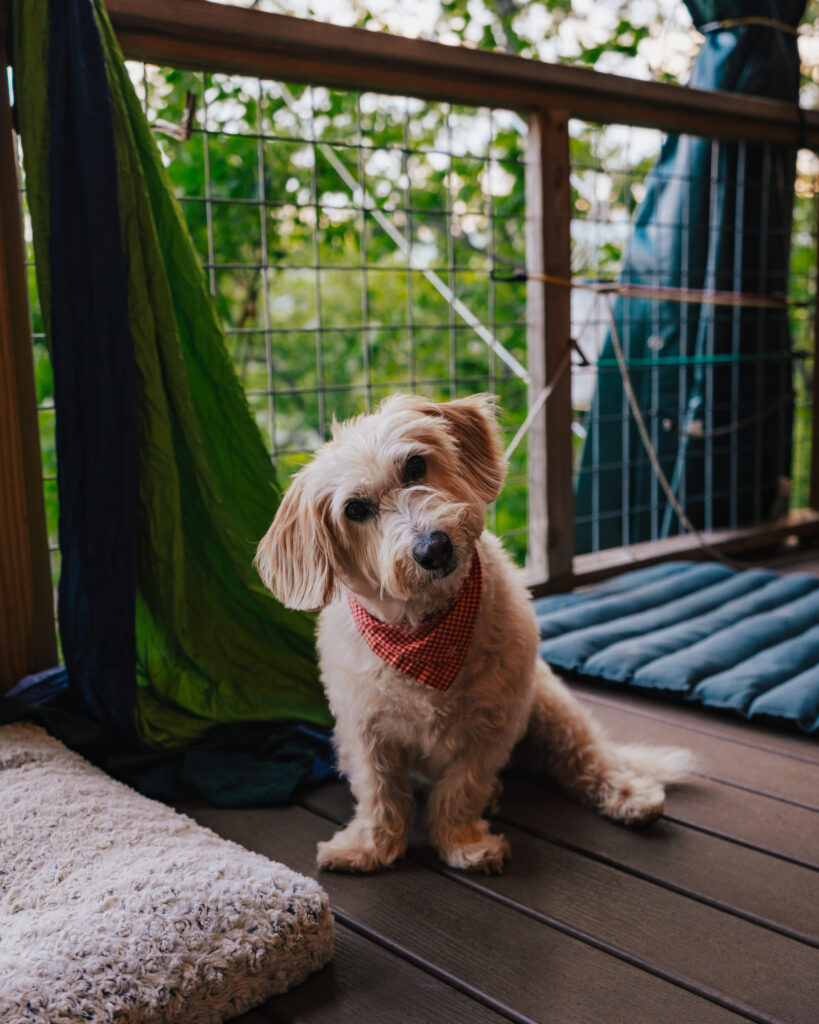
What should I take for my dog when camping?
Think of it like packing for yourself—food, water, a way to sleep comfortably, and the basics that keep them safe. I always bring collapsible bowls, a sleeping bag or bed, a sturdy leash, ID tags, poop bags, and a dog first aid kit.
If they use it at home daily, it probably needs to come along. Add in the extras from this guide and you’ll be set.
Where should my dog sleep when camping?
Most dogs sleep best right in the tent with you. I set up a sleeping bag or bed inside so they have their own warm spot. You know your dog better than I do, so wherever they like to sleep at home, try to mirror it at camp. As long as they’re warm, dry, and off the ground, you’re good to go.
Is camping stressful for dogs?
Some dogs settle in right away, others take a night or two to adjust. If it’s their first time, try a practice camp in the backyard to get them used to the setup.
Stick to their usual routine as much as you can, bring a few comforts from home, and make sure they’re getting plenty of exercise. With a bit of prep, most dogs end up loving camping. After all, it’s time outside with their favorite human.
How do I keep my dog warm while camping?
Layer up just like you would. Start with a sleeping pad or bed to keep them off the ground, then add a blanket or sleeping bag on top.
A jacket or sweater helps on colder nights, and if they’ve gotten wet during the day, dry them off before bed. Keeping them inside the tent with you makes a big difference—they’ll stay warmer, and you’ll both sleep better.
Wrap-Up: Camping Gear For Dogs
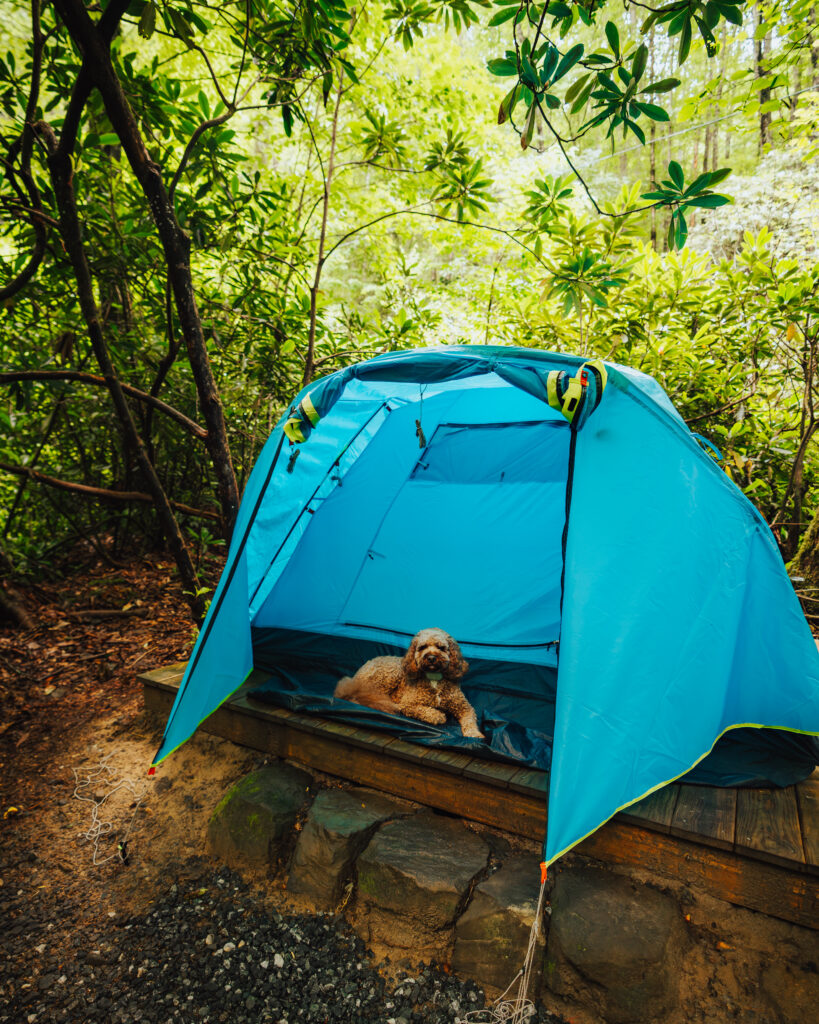
Camping with your dog takes a bit more planning, but once you’re out there, it’s so worth it. With the right gear (and a solid stash of treats), you’re all set for relaxed nights, trail time, and plenty of quality time together.
Pack smart, keep it simple, and enjoy the kind of trip you’ll both be tired and happy from by the time you head home.









